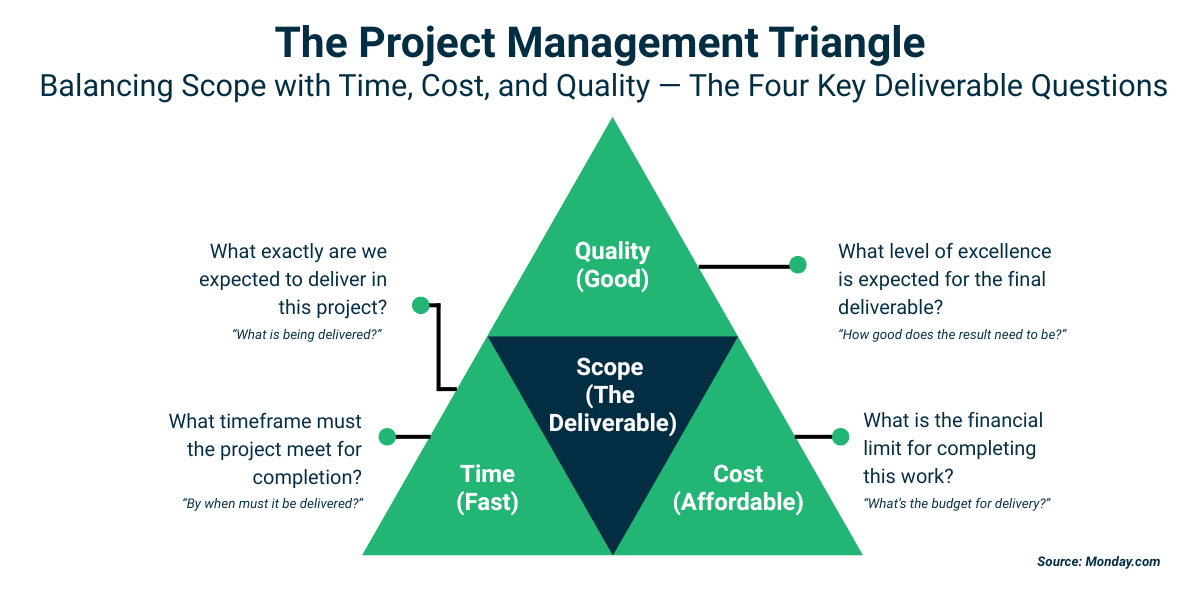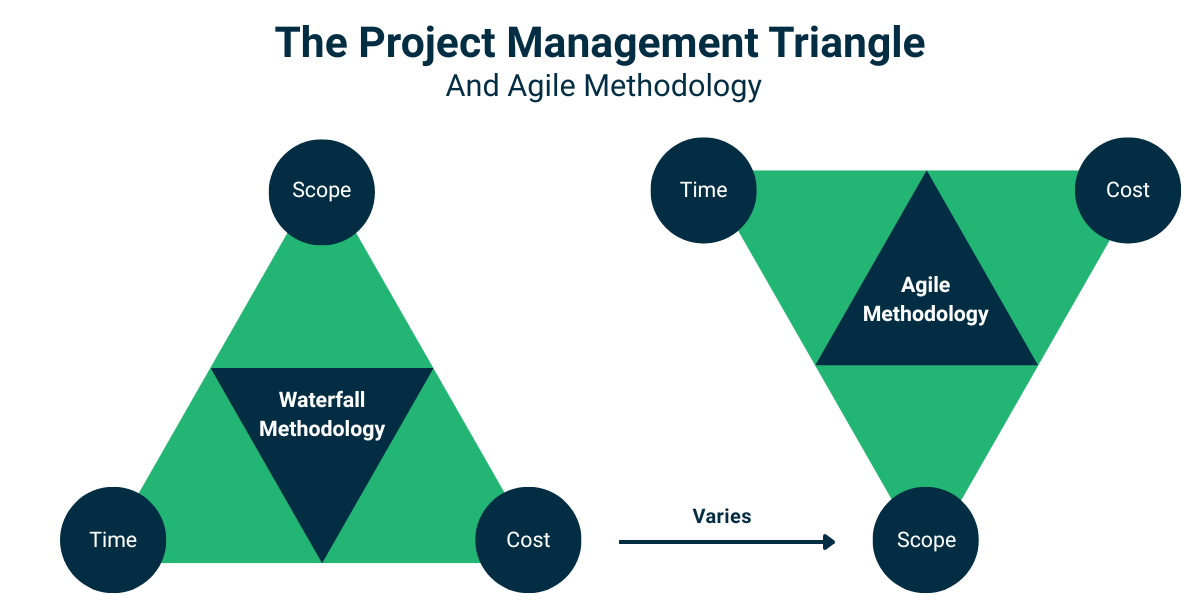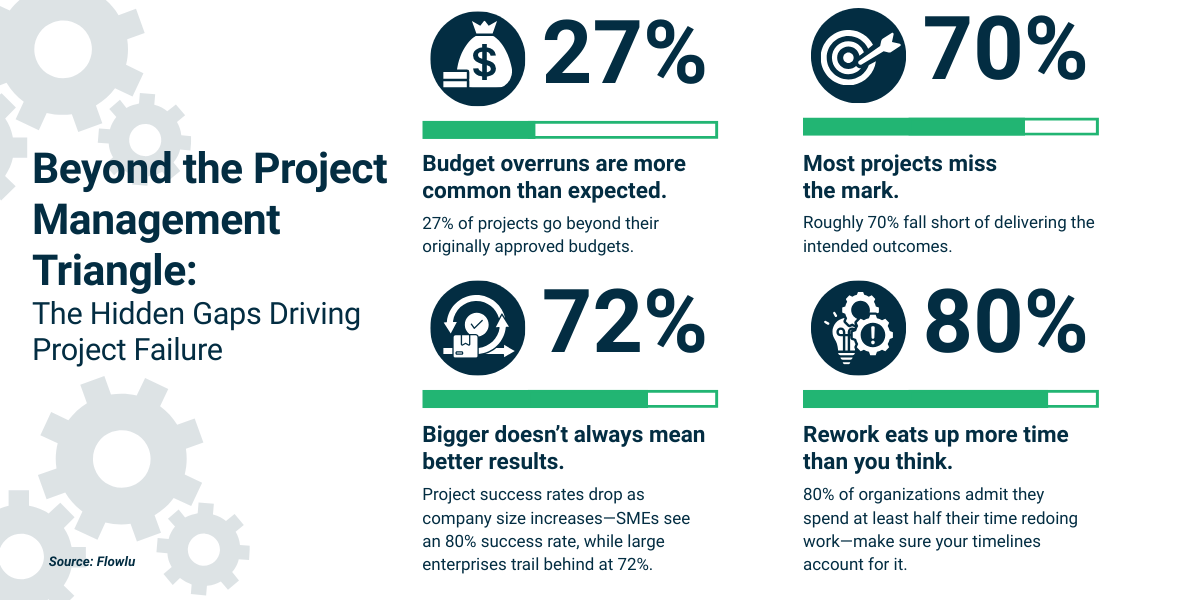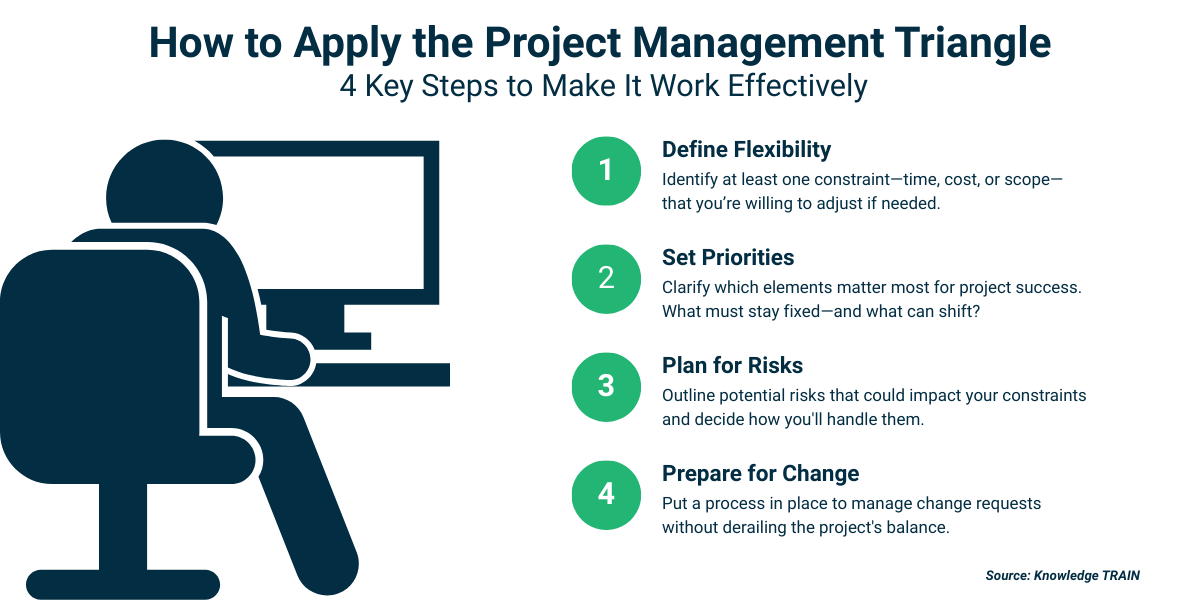
Quick Summary: Every project lives and dies by the triangle of time, cost, and scope—and yet most leaders treat it as a constraint to fight rather than the reality to master. The hard truth is you can’t maximize all three; one must give, and failing to choose early is why deadlines slip, budgets spiral, and outcomes disappoint. Agile and hybrid methods may shift the boundaries, but the triangle hasn’t lost its grip—it remains the decisive framework for trade-offs. Leaders who confront it head-on, set non-negotiables, and use predictive insights to see trouble before it strikes don’t just deliver projects; they build credibility, trust, and results in a world where excuses are no longer tolerated.
Every project begins with optimism—a confident timeline, a defined budget, and a clear vision. But somewhere along the way, projects start slipping. Delivery slows, costs rise, requirements change, teams scramble, and stakeholders grow anxious. What changed? It wasn’t one big failure. It was the quiet crumbling of the balance between time, cost, and scope. This is the reality of the project management triangle. It doesn’t announce itself. But it quietly determines whether your project lands on its feet or collapses under pressure.
Project managers face this dynamic every day. A client adds “just one more feature”, a vendor misses a delivery, or the team’s pace drops—it’s a signal. The triangle is out of balance. And it’s happening faster than you think.
That’s where today’s project leaders need to think differently. Success depends on how consciously leaders manage these dimensions, not just reacting to them. This shift calls for a rethinking of current practices. Here, the artificial intelligence-driven predictive project management solution plays a critical role. A predictive project management solution strengthens the iron triangle by proactively identifying risks and deviations in scope, time, cost, and quality, enabling data-driven decisions before issues escalate.
This article dives into the iron triangle of project management, why it still defines modern project success, and how high-stakes teams use predictive project management to bring clarity and control back into the equation. Because managing projects isn’t just about getting work done—it’s about staying ahead of what could go wrong before it does.

What Is the Project Management Triangle?
The project management triangle is a foundational model that frames every project across three critical constraints: time, cost, and scope. It is also known as the iron triangle in project management.
Imagine these three elements as the corners of a triangle. You can shift or stretch one, but the others will feel the pull. Delivering faster (time) usually means scaling down features (scope) or increasing spending (cost). If a client demands more features, you need more time or money. If the budget is cut, you must limit the scope or extend the delivery timelines.

These are not hypothetical ideas. They are tangible forces influencing stakeholder expectations, team performance, resource allocation, and ultimately, whether the project succeeds or fails.
Studies show that nearly 86% of projects face schedule overruns, and 57% exceed budget. The project management triangle is always in play; ignoring it is not an option.
“Rather than focusing on where teams work, organizations should prioritize how they work--optimizing team collaboration, innovation, agility, and talent retention through flexible frameworks that enable success.”
- PMI
Extended Constraints: Beyond the Traditional Triangle
While the classic project management triangle focuses on time, cost, and scope, modern projects rarely succeed by managing only these three. Several additional constraints have become critical:

- Quality: Delivering on time and within budget means little if the final product lacks quality. Many organizations now place quality at the center of the triangle, recognizing it as the outcome that binds all three dimensions
- Resources: People, solutions, and technology form the foundation of project delivery. Limited skilled resources or over-allocation can derail even the most carefully planned project.
- Risk: Every project carries uncertainty. Unchecked risks can multiply costs, push deadlines, and reduce scope. Proactive risk assessment should sit alongside the triangle as an invisible fourth force.
- Value / Benefits: Ultimately, projects must deliver measurable business benefits. A project delivered “on time and on budget” but failing to achieve intended outcomes still counts as a failure.
Expanding the triangle into a multi-constraint model acknowledges the reality of modern delivery: trade-offs extend beyond three fixed points. Leaders who recognize and manage these hidden forces set their projects apart.
Why the Project Management Triangle Still Matters in Modern Projects
With the rise of agile frameworks, lean thinking, and hybrid delivery models, some have argued that the triangle is outdated. But here’s the truth: it never disappeared—it evolved. In agile environments, for instance, scope becomes flexible while time and cost are fixed. In waterfall models, scope is set while time and cost are adjusted around it. Regardless of the method, the three constraints still govern outcomes.
Where it matters most is communication. Stakeholders want to know:
- What will it cost?
- When will it be delivered?
- What will be delivered?
These aren’t agile vs. waterfall questions. They are business questions. The triangle answers them.
Also, regulatory projects, public sector initiatives, and enterprise programs still rely heavily on traditional metrics. The iron triangle remains a foundation for governance, reporting, and stakeholder alignment.
Here's why the iron triangle matters in modern projects:
- Informs Decisions: The triangle clarifies how changes in scope affect time and cost, enabling smarter resource and schedule choices.
- Clarifies Priorities: Identifying the primary constraint—time, cost, or scope—helps teams focus where it matters most.
- Sets Expectations: It communicates trade-offs clearly, helping stakeholders understand the implications of added features or reduced timelines.
- Prevents Scope Creep: Anchoring decisions to the triangle helps resist uncontrolled changes that risk budget or schedule overruns.
- Improves Risk Management: It reveals how shifts in one constraint impact others, allowing teams to manage risks early.
- Enables Adaptability: The model supports flexibility by guiding how to adjust time or cost when scope changes unexpectedly.
- Drives Value: It focuses on high-impact deliverables, even under constraints.
- Fits Agile Environments: Though rooted in traditional methods, the triangle adapts well to agile’s iterative approach.
The project triangle isn’t obsolete—it’s your strategic edge. Discover how to manage constraints without compromising outcomes. Contact us to learn more!
What Are the Common Pitfalls in Managing the Project Management Triangle
When you don’t manage the iron triangle of project management, it manages you. And the consequences can be severe:
- Overblown Scope: Ambiguous or constantly changing requirements lead to scope creep. Teams scramble to deliver extras that were never approved, quality suffers, and morale dips.
- Unrealistic Timelines: Compressed schedules lead to long nights, missed testing windows, and higher defect rates. Burnout increases, turnover spikes, and shortcuts become standard.
- Underestimated Budgets: Inaccurate forecasting leads to project freezes or budget extensions that undermine trust. Finance teams grow skeptical, and sponsors pull back.
Consider this: McKinsey found that large IT projects run 45% over budget and 7% over time, delivering 56% less value than predicted. Over 17% of IT projects go so badly that they can threaten the very existence of a company. And the worst part? Most of these failures were avoidable. They didn’t happen because teams lacked skills. They happened because no one saw the issues coming early enough.
Strategies to Balance the Project Management Triangle
Let’s move from problem to solution. Here are strategic approaches that high-performing teams adopt to handle the iron triangle of project management. These strategies to balance the project management triangle will help you manage those moving parts effectively, especially when aligned with the five key phases of project management.
1. Define What Matters Most:
You can’t lock all three sides of the project triangle. You must stay flexible. Deciding early on which area—budget, timeline, or scope—takes precedence gives you clarity when challenges arise. Do you need to stay within budget? Then, time or scope may need to flex. If a deadline is firm, ensure you have room in the budget to deal with roadblocks quickly. Having a clear priority keeps you from scrambling when decisions must be made promptly.
2. Set Clear Boundaries and Expectations:
Once your priorities are set, communicate them. Be transparent with clients and stakeholders about what can move and can’t. For industries like construction and engineering, where surprises are common, laying the groundwork early avoids conflict later. Include:
- Pre-approved contingency budgets
- A list of common delay triggers (weather, site issues, etc.)
- Response strategies with estimated time and cost impact
Let stakeholders know what could happen and how you'd respond. Capture their preferences upfront, so you’re aligned from day one.
3. Keep Everyone in the Loop
Plans are only as good as your communication. Share it immediately if something shifts—a resource shortage, vendor delay, or new risk. Timely updates keep trust intact and give everyone time to adjust.
Even if the issue resolves itself, proactive communication shows leadership and preparedness. No one likes surprises, especially when deadlines and budgets are tight.
4. Use Predictive Project Management Tools
This is where the transformation begins. Predictive platforms go beyond dashboards. They analyze task velocity, resource utilization, stakeholder feedback, and progress signals to forecast upcoming issues before they materialize.
- Forecast delays by identifying task slowdowns.
- Alert on cost risks when burn rates exceed thresholds.
- Detect scope creep when new items aren’t aligned with the initial baselines.
You’re no longer reacting. You’re pre-empting.
By making the project management triangle work for you rather than the other way around, you’ll keep control, reduce friction, and drive projects toward success, no matter the challenges.
Stop reacting. Start pre-empting. See how predictive tools help you balance the triangle—your way. Request a personal demo.

Predictive Project Management: A Game-Changer for the Project Management Triangle
Let’s go deeper into what makes predictive solutions indispensable today.
Time Management with Foresight: Instead of static Gantt charts, the predictive solution uses historical data, resource capacity trends, and milestone progress to alert managers about delays before crises occur. For example, if a team historically completes similar features in 6 days but is now trending at 9, the system flags it. Managers can intervene.
Financial Awareness in Real-Time: Costs no longer spiral without warning. The predictive project management solution combines procurement data, contract schedules, and actual expenses to deliver cost risk alerts early. For example, if external vendor delays impact delivery and incur fines, the system recalibrates the forecasted budget and highlights affected deliverables.
Scope Visibility with Context: Not every new feature request is bad. But without context, they pile up and paralyze teams. Predictive tools track how changes affect dependencies, backlog volume, team throughput, and stakeholder impact. You see the big picture—and the trade-offs.
The Result? 360-Degree Control
Predictive project management creates a dynamic view of your triangle. You no longer react to missed deadlines or blown budgets; you operate with foresight, not hindsight.
See what foresight looks like in action. Watch TrueProject’s on-demand demo and experience predictive project management that keeps your triangle in check.
From Constraint to Opportunity: Reimagining Project Success
The project management triangle isn’t just a limitation. Managed well, it becomes a framework for delivering high-value, high-impact results.
The key lies in shifting the mindset:
- From managing outputs to maximizing outcomes.
- From rigid control to data-driven flexibility.
- From guess-based decisions to evidence-based interventions.
Studies highlight that 54% of professionals anticipate that AI will reshape how work is structured, while 53% expect it to enhance the agility of project teams. Additionally, 75% believe AI offers the most outstanding value in managing complex projects over simpler ones.
You’re not just surviving the project management triangle. You’re winning with it.
Conclusion: Turning the Project Management Triangle into a Strategic Asset
The truth is, no project leader can escape the project management triangle. Whether leading a small agile team or delivering a multi-million-dollar transformation, you work within time, cost, and scope constraints. What separates successful leaders from the rest isn't the absence of constraints—it's the ability to stay in control when the pressure builds.
Predictive project management isn't just another solution in the stack. It's how smart teams stay one step ahead, make better decisions, and manage trade-offs with clarity and confidence. It's how you avoid being blindsided, steer projects away from risk, and create breathing room when it matters most.
This is precisely where TrueProject, a KPI-based predictive project management SaaS solution that improves project health and performance, delivers executive value. With deep analytics, continuous feedback loops, and AI-driven foresight, TrueProject empowers leaders to anticipate delivery hurdles, cost fluctuations, and scope risks long before they escalate. It doesn’t just display project data—it interprets it, giving you contextual recommendations and confidence to make strategic calls without waiting for things to break.
Time, cost, and scope don't operate in silos. Neither should your decisions. TrueProject aligns all three through predictive insight, helping you maintain balance and deliver consistently, regardless of project size or complexity.
The triangle doesn't need to be your project’s enemy. With the right insights, it becomes a framework you can shape, not just survive. And when that happens, you're not just managing projects. You're delivering outcomes that matter.
The question isn’t whether the triangle applies to your project. It always does. The real question is—are you leading it, or is it quietly leading you?
Lead the triangle. Don’t let it lead you. Experience how predictive insight turns pressure into performance. Snapshot your projects today.
FAQs for Project Management Triangle
1. What is the difference between the iron triangle, triple constraint, and project management triangle?
They are different names for the same concept—balancing time, cost, and scope to achieve project success. Some models also include quality as the central outcome.
2. Why is quality sometimes called the “fourth constraint”?
Because delivering on time and within cost is meaningless if quality suffers. Many organizations recognize quality as inseparable from the triangle, positioning it as either a fourth corner or the central hub.
3. Which constraint should a project manager prioritize first?
It depends on the project context. Regulatory projects often prioritize scope, product launches prioritize time, and cost-sensitive initiatives prioritize budget. Precise stakeholder alignment is key.
4. How does Agile change the triangle?
In Agile, scope is flexible, and teams deliver incrementally. Time (sprints) and cost (resources per sprint) are fixed. This reverses the rigidity seen in waterfall models.
5. How can predictive intelligence strengthen the triangle?
Predictive tools use data signals (task velocity, stakeholder sentiment, cost burn rates) to forecast issues before they occur. This allows leaders to take preemptive action instead of reacting to failures.
6. What are common mistakes when managing the triangle?
- Failing to set an explicit priority constraint.
- Ignoring scope creep.
- Over-optimistic budgeting or scheduling.
- Lack of transparent communication with stakeholders.
7. Is the project management triangle outdated?
No. While methodologies evolve, the constraints remain the foundation of delivery. Modern approaches simply reinterpret which side is fixed versus flexible.






